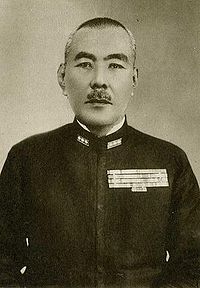- Koshirō Oikawa
-
Koshirō Oikawa
Japanese Admiral Koshirō OikawaBorn 16 February 1883
Morioka, Iwate, JapanDied May 9, 1958 (aged 75)[1] Allegiance Empire of Japan Service/branch  Imperial Japanese Navy
Imperial Japanese NavyYears of service 1897-1945 Rank Admiral Commands held Asashio, Yugiri, Kinu, Tama
IJN 3rd Fleet
Naval Air Command
China Area Fleet
Yokosuka Naval DistrictBattles/wars Russo-Japanese War
Battle of Tsushima
World War IIOther work Minister of the Navy
Supreme War Council (Japan)Koshirō Oikawa (及川 古志郎 Oikawa Koshirō, 16 February 1883 – May 9, 1958) was an admiral in the Imperial Japanese Navy and Naval Minister during World War II.
Contents
Biography
Oikawa was born into a wealthy family in rural Koshi County, Niigata Prefecture, but was raised in Morioka city, Iwate prefecture in northern Japan.
He was a graduate of the 31st class of the Imperial Japanese Naval Academy, ranking 76th out of 188 cadets. As a midshipman, he served on the cruisers Itsukushima and ||ship|Japanese cruiser|Izumo||2}}. During the Russo-Japanese War, still as a midshipman, he served on the Chiyoda during the Battle of Tsushima.
As a lieutenant, Oikawa served on the cruiser Katori, and the battleship Mikasa. He was given his first command, the destroyer Asashio on 28 April 1911. He subsequently served on the Yugiri, before attending the Naval Staff College in 1914.
On graduation, Oikawa was promoted to lieutenant commander, and was appointed aide-de-camp to Crown Prince Hirohito from 1915-1922.
After his promotion to captain on 1 December 1923, Oikawa was assigned the cruiser Kinu, followed by the Tama the following year. He then served in a number of staff positions until his promotion to rear admiral on 10 December 1928. In 1930, Oikawa was appointed to the Imperial Japanese Navy General Staff, and in 1932 became Director of the Imperial Japanese Naval Academy. He was promoted to vice admiral on 15 November 1933. Oikawa strongly supported the London Naval Treaty while a member of the Imperial Japanese Navy General Staff, and was thus a member of the Treaty Faction within the navy.
Oikawa was subsequently appointed Commander in Chief of the IJN 3rd Fleet (1935), Imperial Japanese Navy Aviation Bureau (1936), China Area Fleet (1938) and Yokosuka Naval District (1940). He was promoted to full admiral on 15 November 1939.
Oikawa was appointed as Minister of the Navy in the second and third cabinets of Prime Minister Fumimaro Konoe between 5 September 1940 and 18 October 1941. While Navy Minister, he strove to maintain ties with the United States, and instructed his naval attachés in Washington DC to work together with the Japanese ambassador to prevent war from breaking out. Likewise, he strongly opposed suggestions that Japan should declare war on the Soviet Union in early 1941.[2]
He continued to serve as Naval Councilor to near the end of World War II and was Chief of the Navy General Staff in late 1944. He resigned in protest in May 1945 over Emperor Hirohito's refusal to consider peace proposals at a time when the war was clearly already lost.[3] Oikawa retired from active duty on 5 September 1945.
References
Books
- Bix, Herbert B (2001). Hirohito and the Making of Modern Japan. Harper Perennial. ISBN 0060931302.
- Fuller, Richard (1992). Shokan: Hirohito's Samurai. London: Arms and Armour Press. ISBN 1854091514.
- Spector, Ronald (1985). Eagle Against the Sun: The American War With Japan. Vintage. ISBN 0394741013.
External links
- Nishida, Hiroshi. "Oikawa, Koshiro". Imperial Japanese Navy. http://homepage2.nifty.com/nishidah/e/px31.htm#a001.
- "Oikawa, Koshiro". pp. Pacific War Online Encyclopedia. http://pwencycl.kgbudge.com/O/i/Oikawa_Koshiro.htm.
Notes
Political offices Preceded by
Zengo YoshidaMinister of the Navy
Sep 1940–Oct 1941Succeeded by
Shigetarō ShimadaMilitary offices Preceded by
Shigetarō ShimadaChief of the Imperial Japanese Navy General Staff
Aug 1944 - May 1945Succeeded by
Soemu Toyoda Categories:
Categories:- 1883 births
- 1958 deaths
- People from Morioka
- Imperial Japanese Navy admirals
- Japanese military personnel of the Russo-Japanese War
- Japanese military personnel of World War II
- Ministers of the Navy of Japan
Wikimedia Foundation. 2010.

